The Contemporary Travel and Tourism Industry
VerifiedAdded on 2023/01/18
|15
|4329
|38
AI Summary
This report discusses the key developments and different elements of the travel industry. It explores the factors affecting tourist behavior using motivational theories. It also provides insights into the current patterns and trends in travel and tourism.
Contribute Materials
Your contribution can guide someone’s learning journey. Share your
documents today.
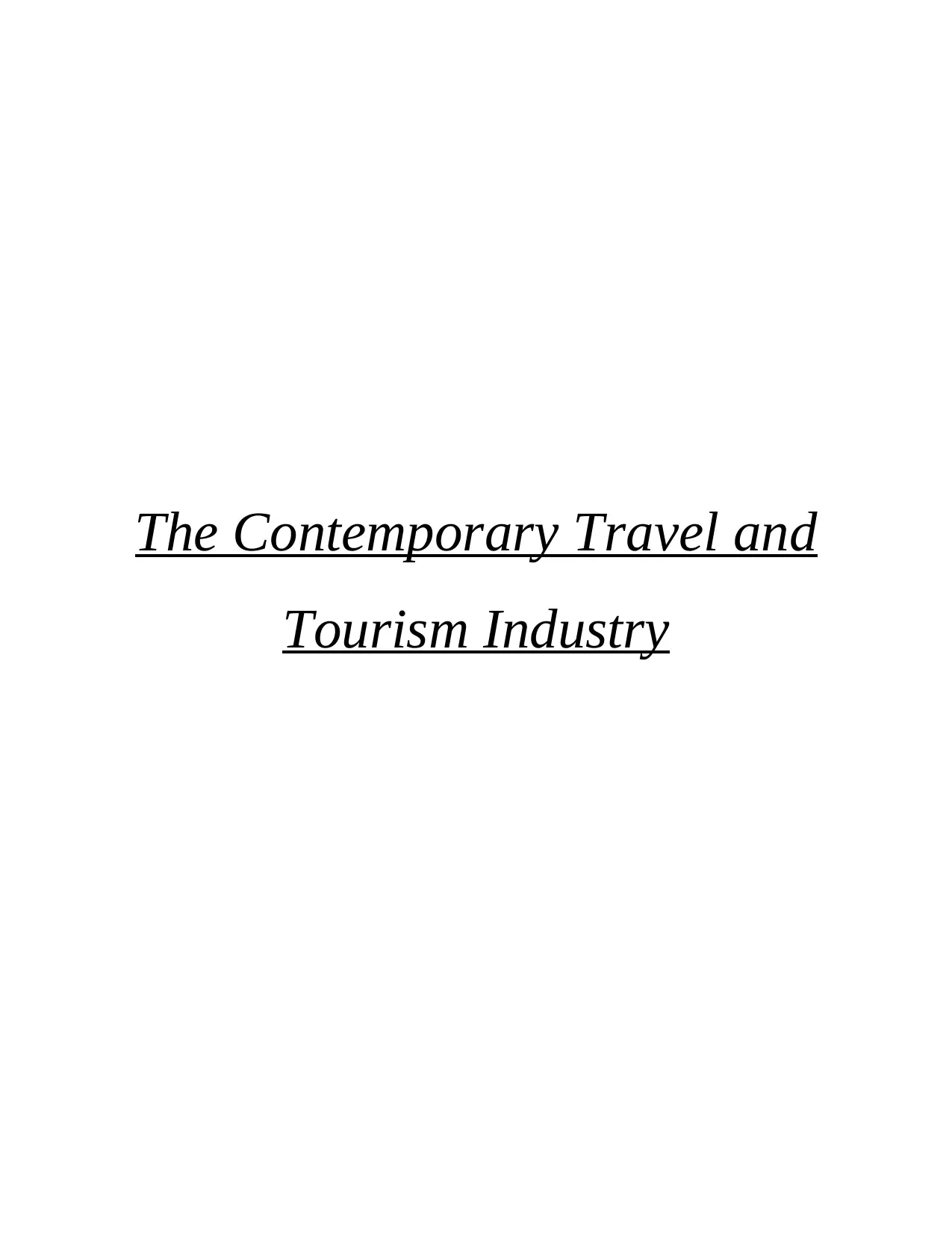
The Contemporary Travel and
Tourism Industry
Tourism Industry
Secure Best Marks with AI Grader
Need help grading? Try our AI Grader for instant feedback on your assignments.
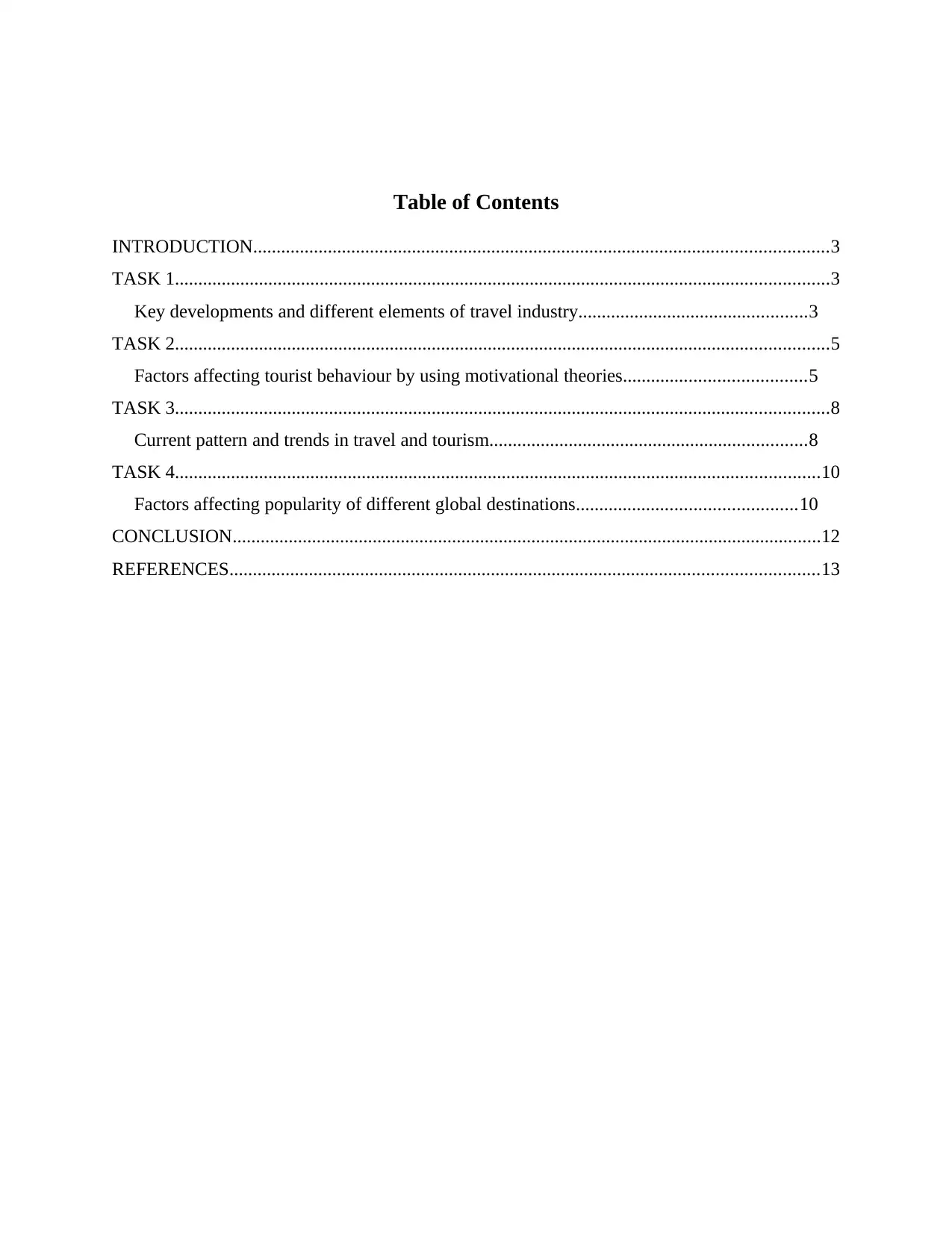
Table of Contents
INTRODUCTION...........................................................................................................................3
TASK 1............................................................................................................................................3
Key developments and different elements of travel industry.................................................3
TASK 2............................................................................................................................................5
Factors affecting tourist behaviour by using motivational theories.......................................5
TASK 3............................................................................................................................................8
Current pattern and trends in travel and tourism....................................................................8
TASK 4..........................................................................................................................................10
Factors affecting popularity of different global destinations...............................................10
CONCLUSION..............................................................................................................................12
REFERENCES..............................................................................................................................13
INTRODUCTION...........................................................................................................................3
TASK 1............................................................................................................................................3
Key developments and different elements of travel industry.................................................3
TASK 2............................................................................................................................................5
Factors affecting tourist behaviour by using motivational theories.......................................5
TASK 3............................................................................................................................................8
Current pattern and trends in travel and tourism....................................................................8
TASK 4..........................................................................................................................................10
Factors affecting popularity of different global destinations...............................................10
CONCLUSION..............................................................................................................................12
REFERENCES..............................................................................................................................13

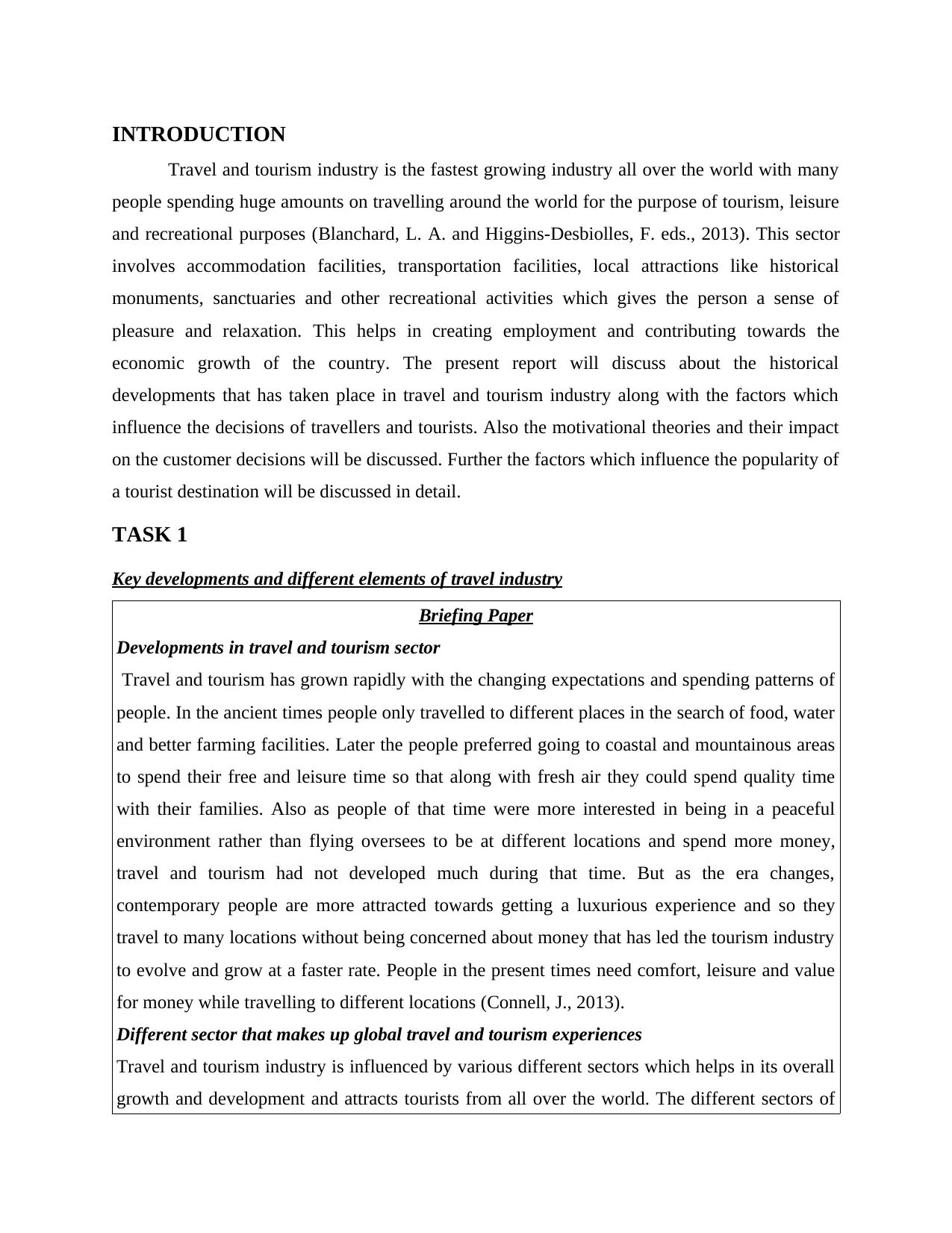
INTRODUCTION
Travel and tourism industry is the fastest growing industry all over the world with many
people spending huge amounts on travelling around the world for the purpose of tourism, leisure
and recreational purposes (Blanchard, L. A. and Higgins-Desbiolles, F. eds., 2013). This sector
involves accommodation facilities, transportation facilities, local attractions like historical
monuments, sanctuaries and other recreational activities which gives the person a sense of
pleasure and relaxation. This helps in creating employment and contributing towards the
economic growth of the country. The present report will discuss about the historical
developments that has taken place in travel and tourism industry along with the factors which
influence the decisions of travellers and tourists. Also the motivational theories and their impact
on the customer decisions will be discussed. Further the factors which influence the popularity of
a tourist destination will be discussed in detail.
TASK 1
Key developments and different elements of travel industry
Briefing Paper
Developments in travel and tourism sector
Travel and tourism has grown rapidly with the changing expectations and spending patterns of
people. In the ancient times people only travelled to different places in the search of food, water
and better farming facilities. Later the people preferred going to coastal and mountainous areas
to spend their free and leisure time so that along with fresh air they could spend quality time
with their families. Also as people of that time were more interested in being in a peaceful
environment rather than flying oversees to be at different locations and spend more money,
travel and tourism had not developed much during that time. But as the era changes,
contemporary people are more attracted towards getting a luxurious experience and so they
travel to many locations without being concerned about money that has led the tourism industry
to evolve and grow at a faster rate. People in the present times need comfort, leisure and value
for money while travelling to different locations (Connell, J., 2013).
Different sector that makes up global travel and tourism experiences
Travel and tourism industry is influenced by various different sectors which helps in its overall
growth and development and attracts tourists from all over the world. The different sectors of
Travel and tourism industry is the fastest growing industry all over the world with many
people spending huge amounts on travelling around the world for the purpose of tourism, leisure
and recreational purposes (Blanchard, L. A. and Higgins-Desbiolles, F. eds., 2013). This sector
involves accommodation facilities, transportation facilities, local attractions like historical
monuments, sanctuaries and other recreational activities which gives the person a sense of
pleasure and relaxation. This helps in creating employment and contributing towards the
economic growth of the country. The present report will discuss about the historical
developments that has taken place in travel and tourism industry along with the factors which
influence the decisions of travellers and tourists. Also the motivational theories and their impact
on the customer decisions will be discussed. Further the factors which influence the popularity of
a tourist destination will be discussed in detail.
TASK 1
Key developments and different elements of travel industry
Briefing Paper
Developments in travel and tourism sector
Travel and tourism has grown rapidly with the changing expectations and spending patterns of
people. In the ancient times people only travelled to different places in the search of food, water
and better farming facilities. Later the people preferred going to coastal and mountainous areas
to spend their free and leisure time so that along with fresh air they could spend quality time
with their families. Also as people of that time were more interested in being in a peaceful
environment rather than flying oversees to be at different locations and spend more money,
travel and tourism had not developed much during that time. But as the era changes,
contemporary people are more attracted towards getting a luxurious experience and so they
travel to many locations without being concerned about money that has led the tourism industry
to evolve and grow at a faster rate. People in the present times need comfort, leisure and value
for money while travelling to different locations (Connell, J., 2013).
Different sector that makes up global travel and tourism experiences
Travel and tourism industry is influenced by various different sectors which helps in its overall
growth and development and attracts tourists from all over the world. The different sectors of
Paraphrase This Document
Need a fresh take? Get an instant paraphrase of this document with our AI Paraphraser
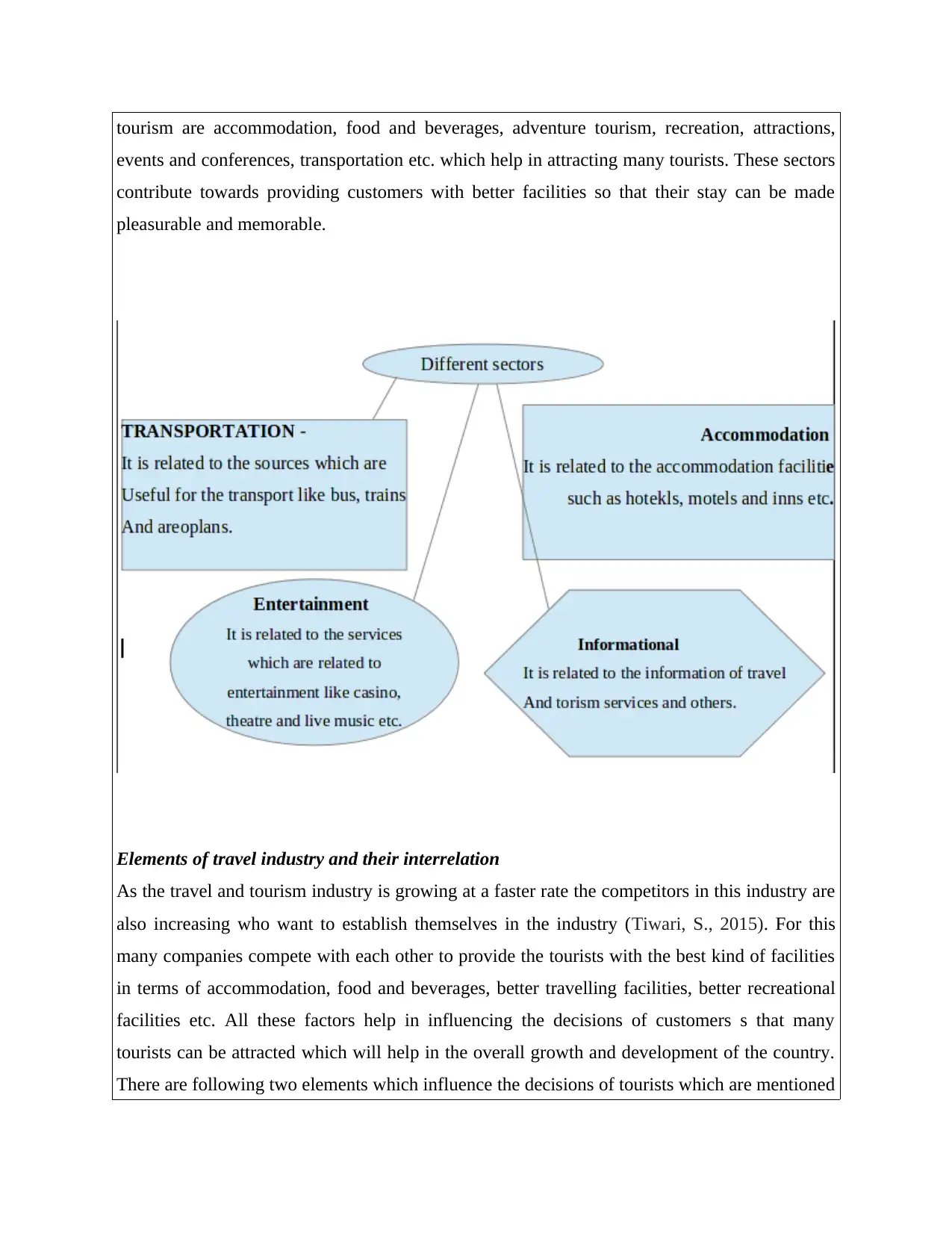
tourism are accommodation, food and beverages, adventure tourism, recreation, attractions,
events and conferences, transportation etc. which help in attracting many tourists. These sectors
contribute towards providing customers with better facilities so that their stay can be made
pleasurable and memorable.
Elements of travel industry and their interrelation
As the travel and tourism industry is growing at a faster rate the competitors in this industry are
also increasing who want to establish themselves in the industry (Tiwari, S., 2015). For this
many companies compete with each other to provide the tourists with the best kind of facilities
in terms of accommodation, food and beverages, better travelling facilities, better recreational
facilities etc. All these factors help in influencing the decisions of customers s that many
tourists can be attracted which will help in the overall growth and development of the country.
There are following two elements which influence the decisions of tourists which are mentioned
events and conferences, transportation etc. which help in attracting many tourists. These sectors
contribute towards providing customers with better facilities so that their stay can be made
pleasurable and memorable.
Elements of travel industry and their interrelation
As the travel and tourism industry is growing at a faster rate the competitors in this industry are
also increasing who want to establish themselves in the industry (Tiwari, S., 2015). For this
many companies compete with each other to provide the tourists with the best kind of facilities
in terms of accommodation, food and beverages, better travelling facilities, better recreational
facilities etc. All these factors help in influencing the decisions of customers s that many
tourists can be attracted which will help in the overall growth and development of the country.
There are following two elements which influence the decisions of tourists which are mentioned
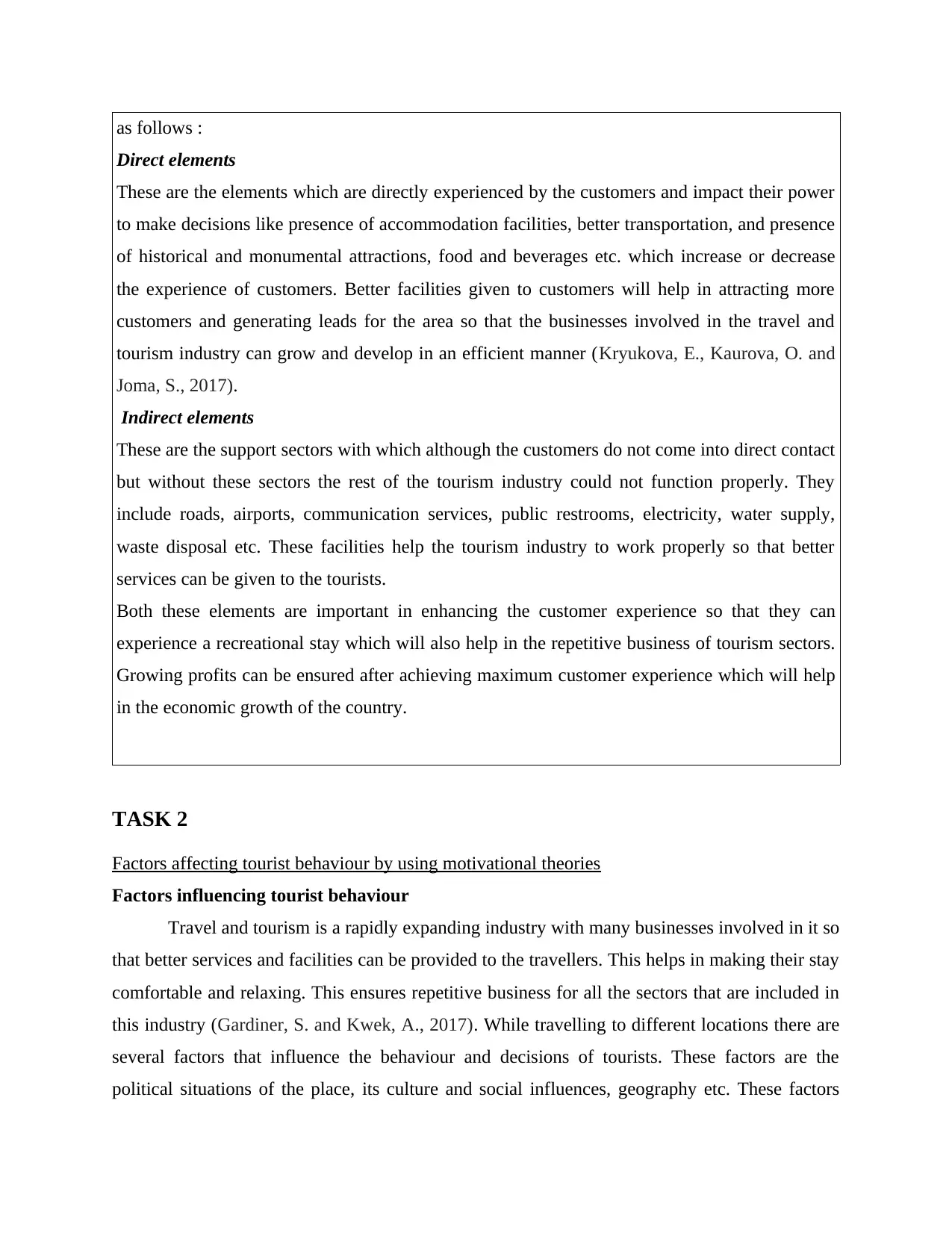
as follows :
Direct elements
These are the elements which are directly experienced by the customers and impact their power
to make decisions like presence of accommodation facilities, better transportation, and presence
of historical and monumental attractions, food and beverages etc. which increase or decrease
the experience of customers. Better facilities given to customers will help in attracting more
customers and generating leads for the area so that the businesses involved in the travel and
tourism industry can grow and develop in an efficient manner (Kryukova, E., Kaurova, O. and
Joma, S., 2017).
Indirect elements
These are the support sectors with which although the customers do not come into direct contact
but without these sectors the rest of the tourism industry could not function properly. They
include roads, airports, communication services, public restrooms, electricity, water supply,
waste disposal etc. These facilities help the tourism industry to work properly so that better
services can be given to the tourists.
Both these elements are important in enhancing the customer experience so that they can
experience a recreational stay which will also help in the repetitive business of tourism sectors.
Growing profits can be ensured after achieving maximum customer experience which will help
in the economic growth of the country.
TASK 2
Factors affecting tourist behaviour by using motivational theories
Factors influencing tourist behaviour
Travel and tourism is a rapidly expanding industry with many businesses involved in it so
that better services and facilities can be provided to the travellers. This helps in making their stay
comfortable and relaxing. This ensures repetitive business for all the sectors that are included in
this industry (Gardiner, S. and Kwek, A., 2017). While travelling to different locations there are
several factors that influence the behaviour and decisions of tourists. These factors are the
political situations of the place, its culture and social influences, geography etc. These factors
Direct elements
These are the elements which are directly experienced by the customers and impact their power
to make decisions like presence of accommodation facilities, better transportation, and presence
of historical and monumental attractions, food and beverages etc. which increase or decrease
the experience of customers. Better facilities given to customers will help in attracting more
customers and generating leads for the area so that the businesses involved in the travel and
tourism industry can grow and develop in an efficient manner (Kryukova, E., Kaurova, O. and
Joma, S., 2017).
Indirect elements
These are the support sectors with which although the customers do not come into direct contact
but without these sectors the rest of the tourism industry could not function properly. They
include roads, airports, communication services, public restrooms, electricity, water supply,
waste disposal etc. These facilities help the tourism industry to work properly so that better
services can be given to the tourists.
Both these elements are important in enhancing the customer experience so that they can
experience a recreational stay which will also help in the repetitive business of tourism sectors.
Growing profits can be ensured after achieving maximum customer experience which will help
in the economic growth of the country.
TASK 2
Factors affecting tourist behaviour by using motivational theories
Factors influencing tourist behaviour
Travel and tourism is a rapidly expanding industry with many businesses involved in it so
that better services and facilities can be provided to the travellers. This helps in making their stay
comfortable and relaxing. This ensures repetitive business for all the sectors that are included in
this industry (Gardiner, S. and Kwek, A., 2017). While travelling to different locations there are
several factors that influence the behaviour and decisions of tourists. These factors are the
political situations of the place, its culture and social influences, geography etc. These factors
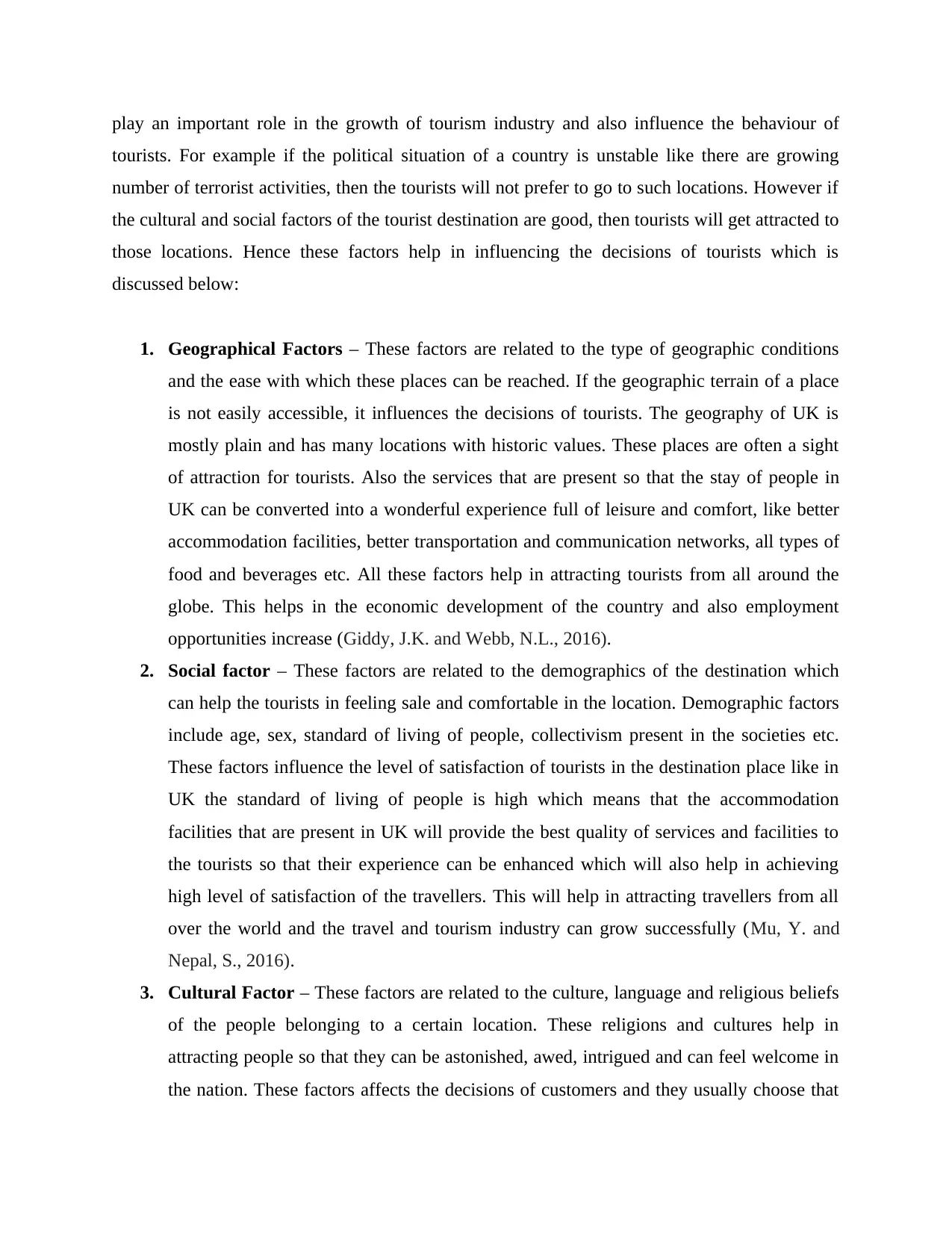
play an important role in the growth of tourism industry and also influence the behaviour of
tourists. For example if the political situation of a country is unstable like there are growing
number of terrorist activities, then the tourists will not prefer to go to such locations. However if
the cultural and social factors of the tourist destination are good, then tourists will get attracted to
those locations. Hence these factors help in influencing the decisions of tourists which is
discussed below:
1. Geographical Factors – These factors are related to the type of geographic conditions
and the ease with which these places can be reached. If the geographic terrain of a place
is not easily accessible, it influences the decisions of tourists. The geography of UK is
mostly plain and has many locations with historic values. These places are often a sight
of attraction for tourists. Also the services that are present so that the stay of people in
UK can be converted into a wonderful experience full of leisure and comfort, like better
accommodation facilities, better transportation and communication networks, all types of
food and beverages etc. All these factors help in attracting tourists from all around the
globe. This helps in the economic development of the country and also employment
opportunities increase (Giddy, J.K. and Webb, N.L., 2016).
2. Social factor – These factors are related to the demographics of the destination which
can help the tourists in feeling sale and comfortable in the location. Demographic factors
include age, sex, standard of living of people, collectivism present in the societies etc.
These factors influence the level of satisfaction of tourists in the destination place like in
UK the standard of living of people is high which means that the accommodation
facilities that are present in UK will provide the best quality of services and facilities to
the tourists so that their experience can be enhanced which will also help in achieving
high level of satisfaction of the travellers. This will help in attracting travellers from all
over the world and the travel and tourism industry can grow successfully (Mu, Y. and
Nepal, S., 2016).
3. Cultural Factor – These factors are related to the culture, language and religious beliefs
of the people belonging to a certain location. These religions and cultures help in
attracting people so that they can be astonished, awed, intrigued and can feel welcome in
the nation. These factors affects the decisions of customers and they usually choose that
tourists. For example if the political situation of a country is unstable like there are growing
number of terrorist activities, then the tourists will not prefer to go to such locations. However if
the cultural and social factors of the tourist destination are good, then tourists will get attracted to
those locations. Hence these factors help in influencing the decisions of tourists which is
discussed below:
1. Geographical Factors – These factors are related to the type of geographic conditions
and the ease with which these places can be reached. If the geographic terrain of a place
is not easily accessible, it influences the decisions of tourists. The geography of UK is
mostly plain and has many locations with historic values. These places are often a sight
of attraction for tourists. Also the services that are present so that the stay of people in
UK can be converted into a wonderful experience full of leisure and comfort, like better
accommodation facilities, better transportation and communication networks, all types of
food and beverages etc. All these factors help in attracting tourists from all around the
globe. This helps in the economic development of the country and also employment
opportunities increase (Giddy, J.K. and Webb, N.L., 2016).
2. Social factor – These factors are related to the demographics of the destination which
can help the tourists in feeling sale and comfortable in the location. Demographic factors
include age, sex, standard of living of people, collectivism present in the societies etc.
These factors influence the level of satisfaction of tourists in the destination place like in
UK the standard of living of people is high which means that the accommodation
facilities that are present in UK will provide the best quality of services and facilities to
the tourists so that their experience can be enhanced which will also help in achieving
high level of satisfaction of the travellers. This will help in attracting travellers from all
over the world and the travel and tourism industry can grow successfully (Mu, Y. and
Nepal, S., 2016).
3. Cultural Factor – These factors are related to the culture, language and religious beliefs
of the people belonging to a certain location. These religions and cultures help in
attracting people so that they can be astonished, awed, intrigued and can feel welcome in
the nation. These factors affects the decisions of customers and they usually choose that
Secure Best Marks with AI Grader
Need help grading? Try our AI Grader for instant feedback on your assignments.
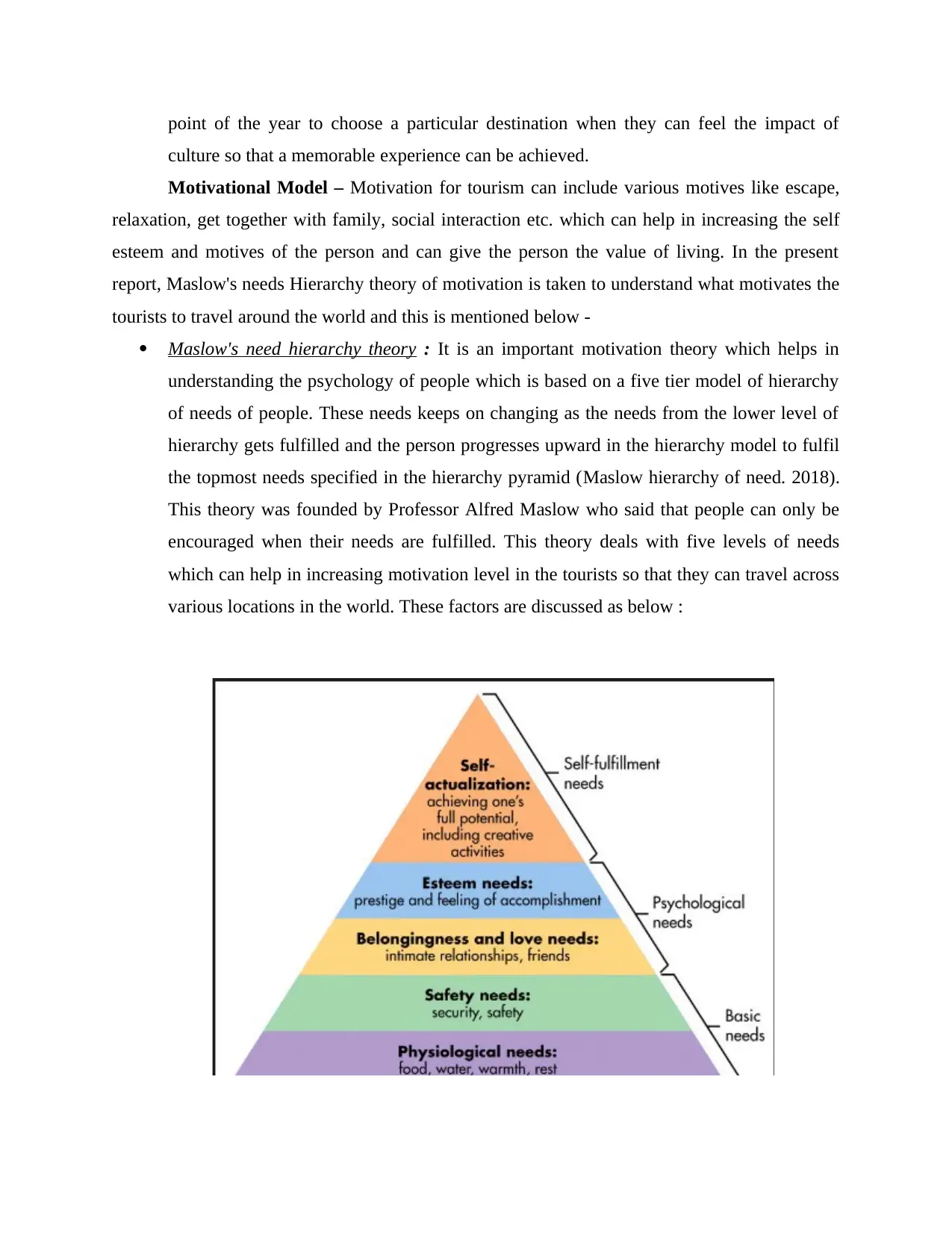
point of the year to choose a particular destination when they can feel the impact of
culture so that a memorable experience can be achieved.
Motivational Model – Motivation for tourism can include various motives like escape,
relaxation, get together with family, social interaction etc. which can help in increasing the self
esteem and motives of the person and can give the person the value of living. In the present
report, Maslow's needs Hierarchy theory of motivation is taken to understand what motivates the
tourists to travel around the world and this is mentioned below -
Maslow's need hierarchy theory : It is an important motivation theory which helps in
understanding the psychology of people which is based on a five tier model of hierarchy
of needs of people. These needs keeps on changing as the needs from the lower level of
hierarchy gets fulfilled and the person progresses upward in the hierarchy model to fulfil
the topmost needs specified in the hierarchy pyramid (Maslow hierarchy of need. 2018).
This theory was founded by Professor Alfred Maslow who said that people can only be
encouraged when their needs are fulfilled. This theory deals with five levels of needs
which can help in increasing motivation level in the tourists so that they can travel across
various locations in the world. These factors are discussed as below :
culture so that a memorable experience can be achieved.
Motivational Model – Motivation for tourism can include various motives like escape,
relaxation, get together with family, social interaction etc. which can help in increasing the self
esteem and motives of the person and can give the person the value of living. In the present
report, Maslow's needs Hierarchy theory of motivation is taken to understand what motivates the
tourists to travel around the world and this is mentioned below -
Maslow's need hierarchy theory : It is an important motivation theory which helps in
understanding the psychology of people which is based on a five tier model of hierarchy
of needs of people. These needs keeps on changing as the needs from the lower level of
hierarchy gets fulfilled and the person progresses upward in the hierarchy model to fulfil
the topmost needs specified in the hierarchy pyramid (Maslow hierarchy of need. 2018).
This theory was founded by Professor Alfred Maslow who said that people can only be
encouraged when their needs are fulfilled. This theory deals with five levels of needs
which can help in increasing motivation level in the tourists so that they can travel across
various locations in the world. These factors are discussed as below :
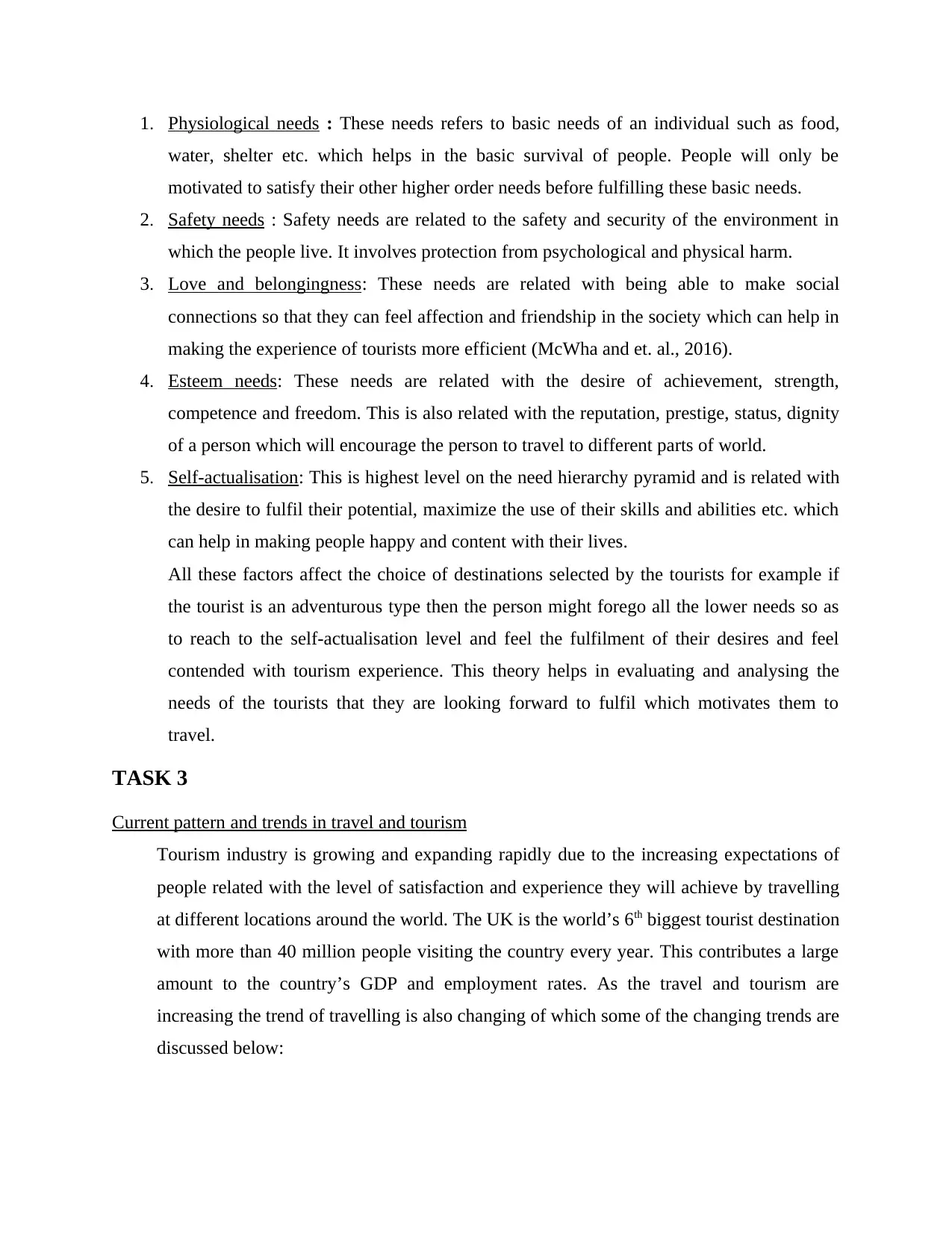
1. Physiological needs : These needs refers to basic needs of an individual such as food,
water, shelter etc. which helps in the basic survival of people. People will only be
motivated to satisfy their other higher order needs before fulfilling these basic needs.
2. Safety needs : Safety needs are related to the safety and security of the environment in
which the people live. It involves protection from psychological and physical harm.
3. Love and belongingness: These needs are related with being able to make social
connections so that they can feel affection and friendship in the society which can help in
making the experience of tourists more efficient (McWha and et. al., 2016).
4. Esteem needs: These needs are related with the desire of achievement, strength,
competence and freedom. This is also related with the reputation, prestige, status, dignity
of a person which will encourage the person to travel to different parts of world.
5. Self-actualisation: This is highest level on the need hierarchy pyramid and is related with
the desire to fulfil their potential, maximize the use of their skills and abilities etc. which
can help in making people happy and content with their lives.
All these factors affect the choice of destinations selected by the tourists for example if
the tourist is an adventurous type then the person might forego all the lower needs so as
to reach to the self-actualisation level and feel the fulfilment of their desires and feel
contended with tourism experience. This theory helps in evaluating and analysing the
needs of the tourists that they are looking forward to fulfil which motivates them to
travel.
TASK 3
Current pattern and trends in travel and tourism
Tourism industry is growing and expanding rapidly due to the increasing expectations of
people related with the level of satisfaction and experience they will achieve by travelling
at different locations around the world. The UK is the world’s 6th biggest tourist destination
with more than 40 million people visiting the country every year. This contributes a large
amount to the country’s GDP and employment rates. As the travel and tourism are
increasing the trend of travelling is also changing of which some of the changing trends are
discussed below:
water, shelter etc. which helps in the basic survival of people. People will only be
motivated to satisfy their other higher order needs before fulfilling these basic needs.
2. Safety needs : Safety needs are related to the safety and security of the environment in
which the people live. It involves protection from psychological and physical harm.
3. Love and belongingness: These needs are related with being able to make social
connections so that they can feel affection and friendship in the society which can help in
making the experience of tourists more efficient (McWha and et. al., 2016).
4. Esteem needs: These needs are related with the desire of achievement, strength,
competence and freedom. This is also related with the reputation, prestige, status, dignity
of a person which will encourage the person to travel to different parts of world.
5. Self-actualisation: This is highest level on the need hierarchy pyramid and is related with
the desire to fulfil their potential, maximize the use of their skills and abilities etc. which
can help in making people happy and content with their lives.
All these factors affect the choice of destinations selected by the tourists for example if
the tourist is an adventurous type then the person might forego all the lower needs so as
to reach to the self-actualisation level and feel the fulfilment of their desires and feel
contended with tourism experience. This theory helps in evaluating and analysing the
needs of the tourists that they are looking forward to fulfil which motivates them to
travel.
TASK 3
Current pattern and trends in travel and tourism
Tourism industry is growing and expanding rapidly due to the increasing expectations of
people related with the level of satisfaction and experience they will achieve by travelling
at different locations around the world. The UK is the world’s 6th biggest tourist destination
with more than 40 million people visiting the country every year. This contributes a large
amount to the country’s GDP and employment rates. As the travel and tourism are
increasing the trend of travelling is also changing of which some of the changing trends are
discussed below:
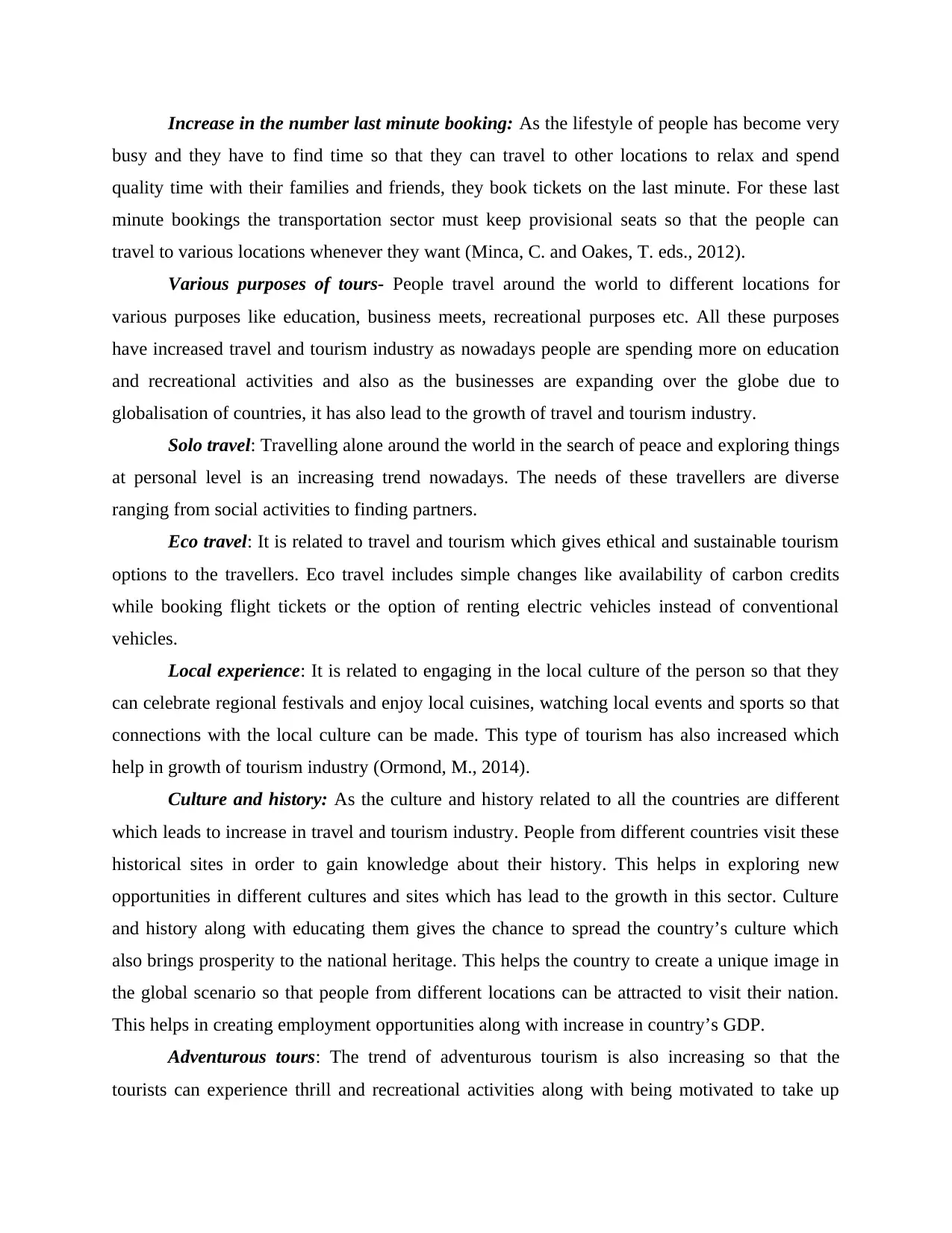
Increase in the number last minute booking: As the lifestyle of people has become very
busy and they have to find time so that they can travel to other locations to relax and spend
quality time with their families and friends, they book tickets on the last minute. For these last
minute bookings the transportation sector must keep provisional seats so that the people can
travel to various locations whenever they want (Minca, C. and Oakes, T. eds., 2012).
Various purposes of tours- People travel around the world to different locations for
various purposes like education, business meets, recreational purposes etc. All these purposes
have increased travel and tourism industry as nowadays people are spending more on education
and recreational activities and also as the businesses are expanding over the globe due to
globalisation of countries, it has also lead to the growth of travel and tourism industry.
Solo travel: Travelling alone around the world in the search of peace and exploring things
at personal level is an increasing trend nowadays. The needs of these travellers are diverse
ranging from social activities to finding partners.
Eco travel: It is related to travel and tourism which gives ethical and sustainable tourism
options to the travellers. Eco travel includes simple changes like availability of carbon credits
while booking flight tickets or the option of renting electric vehicles instead of conventional
vehicles.
Local experience: It is related to engaging in the local culture of the person so that they
can celebrate regional festivals and enjoy local cuisines, watching local events and sports so that
connections with the local culture can be made. This type of tourism has also increased which
help in growth of tourism industry (Ormond, M., 2014).
Culture and history: As the culture and history related to all the countries are different
which leads to increase in travel and tourism industry. People from different countries visit these
historical sites in order to gain knowledge about their history. This helps in exploring new
opportunities in different cultures and sites which has lead to the growth in this sector. Culture
and history along with educating them gives the chance to spread the country’s culture which
also brings prosperity to the national heritage. This helps the country to create a unique image in
the global scenario so that people from different locations can be attracted to visit their nation.
This helps in creating employment opportunities along with increase in country’s GDP.
Adventurous tours: The trend of adventurous tourism is also increasing so that the
tourists can experience thrill and recreational activities along with being motivated to take up
busy and they have to find time so that they can travel to other locations to relax and spend
quality time with their families and friends, they book tickets on the last minute. For these last
minute bookings the transportation sector must keep provisional seats so that the people can
travel to various locations whenever they want (Minca, C. and Oakes, T. eds., 2012).
Various purposes of tours- People travel around the world to different locations for
various purposes like education, business meets, recreational purposes etc. All these purposes
have increased travel and tourism industry as nowadays people are spending more on education
and recreational activities and also as the businesses are expanding over the globe due to
globalisation of countries, it has also lead to the growth of travel and tourism industry.
Solo travel: Travelling alone around the world in the search of peace and exploring things
at personal level is an increasing trend nowadays. The needs of these travellers are diverse
ranging from social activities to finding partners.
Eco travel: It is related to travel and tourism which gives ethical and sustainable tourism
options to the travellers. Eco travel includes simple changes like availability of carbon credits
while booking flight tickets or the option of renting electric vehicles instead of conventional
vehicles.
Local experience: It is related to engaging in the local culture of the person so that they
can celebrate regional festivals and enjoy local cuisines, watching local events and sports so that
connections with the local culture can be made. This type of tourism has also increased which
help in growth of tourism industry (Ormond, M., 2014).
Culture and history: As the culture and history related to all the countries are different
which leads to increase in travel and tourism industry. People from different countries visit these
historical sites in order to gain knowledge about their history. This helps in exploring new
opportunities in different cultures and sites which has lead to the growth in this sector. Culture
and history along with educating them gives the chance to spread the country’s culture which
also brings prosperity to the national heritage. This helps the country to create a unique image in
the global scenario so that people from different locations can be attracted to visit their nation.
This helps in creating employment opportunities along with increase in country’s GDP.
Adventurous tours: The trend of adventurous tourism is also increasing so that the
tourists can experience thrill and recreational activities along with being motivated to take up
Paraphrase This Document
Need a fresh take? Get an instant paraphrase of this document with our AI Paraphraser
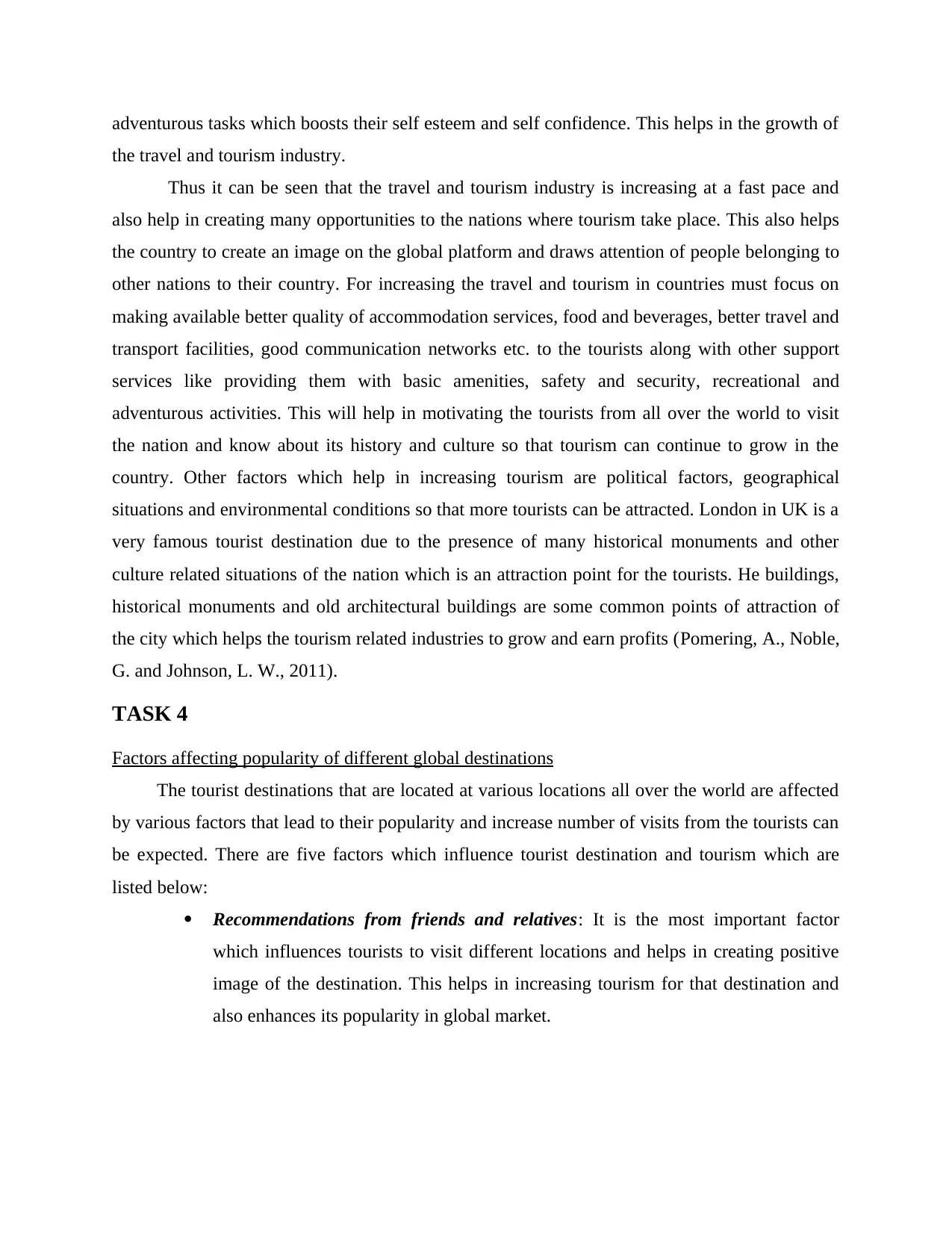
adventurous tasks which boosts their self esteem and self confidence. This helps in the growth of
the travel and tourism industry.
Thus it can be seen that the travel and tourism industry is increasing at a fast pace and
also help in creating many opportunities to the nations where tourism take place. This also helps
the country to create an image on the global platform and draws attention of people belonging to
other nations to their country. For increasing the travel and tourism in countries must focus on
making available better quality of accommodation services, food and beverages, better travel and
transport facilities, good communication networks etc. to the tourists along with other support
services like providing them with basic amenities, safety and security, recreational and
adventurous activities. This will help in motivating the tourists from all over the world to visit
the nation and know about its history and culture so that tourism can continue to grow in the
country. Other factors which help in increasing tourism are political factors, geographical
situations and environmental conditions so that more tourists can be attracted. London in UK is a
very famous tourist destination due to the presence of many historical monuments and other
culture related situations of the nation which is an attraction point for the tourists. He buildings,
historical monuments and old architectural buildings are some common points of attraction of
the city which helps the tourism related industries to grow and earn profits (Pomering, A., Noble,
G. and Johnson, L. W., 2011).
TASK 4
Factors affecting popularity of different global destinations
The tourist destinations that are located at various locations all over the world are affected
by various factors that lead to their popularity and increase number of visits from the tourists can
be expected. There are five factors which influence tourist destination and tourism which are
listed below:
Recommendations from friends and relatives: It is the most important factor
which influences tourists to visit different locations and helps in creating positive
image of the destination. This helps in increasing tourism for that destination and
also enhances its popularity in global market.
the travel and tourism industry.
Thus it can be seen that the travel and tourism industry is increasing at a fast pace and
also help in creating many opportunities to the nations where tourism take place. This also helps
the country to create an image on the global platform and draws attention of people belonging to
other nations to their country. For increasing the travel and tourism in countries must focus on
making available better quality of accommodation services, food and beverages, better travel and
transport facilities, good communication networks etc. to the tourists along with other support
services like providing them with basic amenities, safety and security, recreational and
adventurous activities. This will help in motivating the tourists from all over the world to visit
the nation and know about its history and culture so that tourism can continue to grow in the
country. Other factors which help in increasing tourism are political factors, geographical
situations and environmental conditions so that more tourists can be attracted. London in UK is a
very famous tourist destination due to the presence of many historical monuments and other
culture related situations of the nation which is an attraction point for the tourists. He buildings,
historical monuments and old architectural buildings are some common points of attraction of
the city which helps the tourism related industries to grow and earn profits (Pomering, A., Noble,
G. and Johnson, L. W., 2011).
TASK 4
Factors affecting popularity of different global destinations
The tourist destinations that are located at various locations all over the world are affected
by various factors that lead to their popularity and increase number of visits from the tourists can
be expected. There are five factors which influence tourist destination and tourism which are
listed below:
Recommendations from friends and relatives: It is the most important factor
which influences tourists to visit different locations and helps in creating positive
image of the destination. This helps in increasing tourism for that destination and
also enhances its popularity in global market.
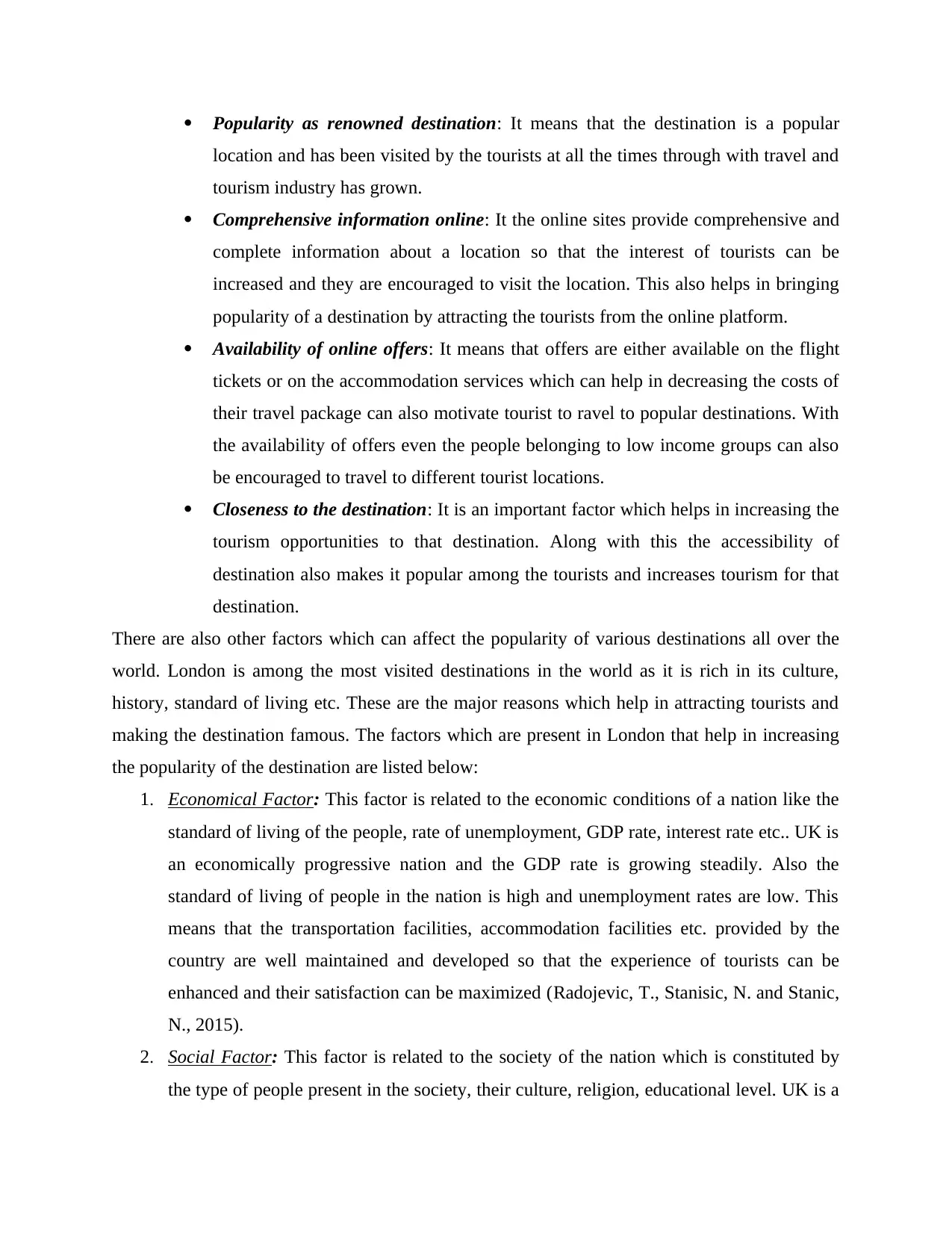
Popularity as renowned destination: It means that the destination is a popular
location and has been visited by the tourists at all the times through with travel and
tourism industry has grown.
Comprehensive information online: It the online sites provide comprehensive and
complete information about a location so that the interest of tourists can be
increased and they are encouraged to visit the location. This also helps in bringing
popularity of a destination by attracting the tourists from the online platform.
Availability of online offers: It means that offers are either available on the flight
tickets or on the accommodation services which can help in decreasing the costs of
their travel package can also motivate tourist to ravel to popular destinations. With
the availability of offers even the people belonging to low income groups can also
be encouraged to travel to different tourist locations.
Closeness to the destination: It is an important factor which helps in increasing the
tourism opportunities to that destination. Along with this the accessibility of
destination also makes it popular among the tourists and increases tourism for that
destination.
There are also other factors which can affect the popularity of various destinations all over the
world. London is among the most visited destinations in the world as it is rich in its culture,
history, standard of living etc. These are the major reasons which help in attracting tourists and
making the destination famous. The factors which are present in London that help in increasing
the popularity of the destination are listed below:
1. Economical Factor: This factor is related to the economic conditions of a nation like the
standard of living of the people, rate of unemployment, GDP rate, interest rate etc.. UK is
an economically progressive nation and the GDP rate is growing steadily. Also the
standard of living of people in the nation is high and unemployment rates are low. This
means that the transportation facilities, accommodation facilities etc. provided by the
country are well maintained and developed so that the experience of tourists can be
enhanced and their satisfaction can be maximized (Radojevic, T., Stanisic, N. and Stanic,
N., 2015).
2. Social Factor: This factor is related to the society of the nation which is constituted by
the type of people present in the society, their culture, religion, educational level. UK is a
location and has been visited by the tourists at all the times through with travel and
tourism industry has grown.
Comprehensive information online: It the online sites provide comprehensive and
complete information about a location so that the interest of tourists can be
increased and they are encouraged to visit the location. This also helps in bringing
popularity of a destination by attracting the tourists from the online platform.
Availability of online offers: It means that offers are either available on the flight
tickets or on the accommodation services which can help in decreasing the costs of
their travel package can also motivate tourist to ravel to popular destinations. With
the availability of offers even the people belonging to low income groups can also
be encouraged to travel to different tourist locations.
Closeness to the destination: It is an important factor which helps in increasing the
tourism opportunities to that destination. Along with this the accessibility of
destination also makes it popular among the tourists and increases tourism for that
destination.
There are also other factors which can affect the popularity of various destinations all over the
world. London is among the most visited destinations in the world as it is rich in its culture,
history, standard of living etc. These are the major reasons which help in attracting tourists and
making the destination famous. The factors which are present in London that help in increasing
the popularity of the destination are listed below:
1. Economical Factor: This factor is related to the economic conditions of a nation like the
standard of living of the people, rate of unemployment, GDP rate, interest rate etc.. UK is
an economically progressive nation and the GDP rate is growing steadily. Also the
standard of living of people in the nation is high and unemployment rates are low. This
means that the transportation facilities, accommodation facilities etc. provided by the
country are well maintained and developed so that the experience of tourists can be
enhanced and their satisfaction can be maximized (Radojevic, T., Stanisic, N. and Stanic,
N., 2015).
2. Social Factor: This factor is related to the society of the nation which is constituted by
the type of people present in the society, their culture, religion, educational level. UK is a
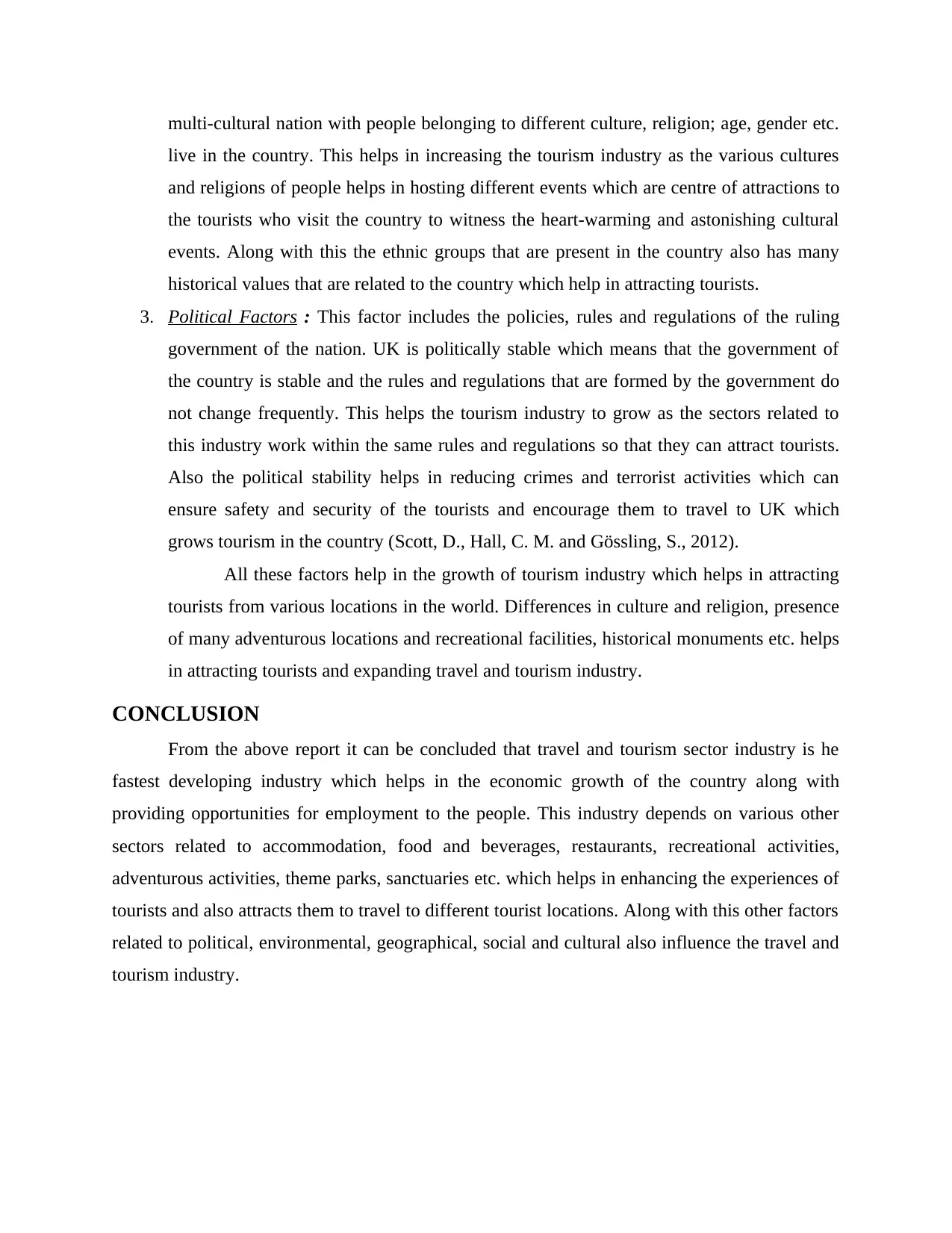
multi-cultural nation with people belonging to different culture, religion; age, gender etc.
live in the country. This helps in increasing the tourism industry as the various cultures
and religions of people helps in hosting different events which are centre of attractions to
the tourists who visit the country to witness the heart-warming and astonishing cultural
events. Along with this the ethnic groups that are present in the country also has many
historical values that are related to the country which help in attracting tourists.
3. Political Factors : This factor includes the policies, rules and regulations of the ruling
government of the nation. UK is politically stable which means that the government of
the country is stable and the rules and regulations that are formed by the government do
not change frequently. This helps the tourism industry to grow as the sectors related to
this industry work within the same rules and regulations so that they can attract tourists.
Also the political stability helps in reducing crimes and terrorist activities which can
ensure safety and security of the tourists and encourage them to travel to UK which
grows tourism in the country (Scott, D., Hall, C. M. and Gössling, S., 2012).
All these factors help in the growth of tourism industry which helps in attracting
tourists from various locations in the world. Differences in culture and religion, presence
of many adventurous locations and recreational facilities, historical monuments etc. helps
in attracting tourists and expanding travel and tourism industry.
CONCLUSION
From the above report it can be concluded that travel and tourism sector industry is he
fastest developing industry which helps in the economic growth of the country along with
providing opportunities for employment to the people. This industry depends on various other
sectors related to accommodation, food and beverages, restaurants, recreational activities,
adventurous activities, theme parks, sanctuaries etc. which helps in enhancing the experiences of
tourists and also attracts them to travel to different tourist locations. Along with this other factors
related to political, environmental, geographical, social and cultural also influence the travel and
tourism industry.
live in the country. This helps in increasing the tourism industry as the various cultures
and religions of people helps in hosting different events which are centre of attractions to
the tourists who visit the country to witness the heart-warming and astonishing cultural
events. Along with this the ethnic groups that are present in the country also has many
historical values that are related to the country which help in attracting tourists.
3. Political Factors : This factor includes the policies, rules and regulations of the ruling
government of the nation. UK is politically stable which means that the government of
the country is stable and the rules and regulations that are formed by the government do
not change frequently. This helps the tourism industry to grow as the sectors related to
this industry work within the same rules and regulations so that they can attract tourists.
Also the political stability helps in reducing crimes and terrorist activities which can
ensure safety and security of the tourists and encourage them to travel to UK which
grows tourism in the country (Scott, D., Hall, C. M. and Gössling, S., 2012).
All these factors help in the growth of tourism industry which helps in attracting
tourists from various locations in the world. Differences in culture and religion, presence
of many adventurous locations and recreational facilities, historical monuments etc. helps
in attracting tourists and expanding travel and tourism industry.
CONCLUSION
From the above report it can be concluded that travel and tourism sector industry is he
fastest developing industry which helps in the economic growth of the country along with
providing opportunities for employment to the people. This industry depends on various other
sectors related to accommodation, food and beverages, restaurants, recreational activities,
adventurous activities, theme parks, sanctuaries etc. which helps in enhancing the experiences of
tourists and also attracts them to travel to different tourist locations. Along with this other factors
related to political, environmental, geographical, social and cultural also influence the travel and
tourism industry.
Secure Best Marks with AI Grader
Need help grading? Try our AI Grader for instant feedback on your assignments.

REFERENCES
Books and Journals
Blanchard, L. A. and Higgins-Desbiolles, F. eds., 2013. Peace through tourism: Promoting
human security through international citizenship. Routledge.
Connell, J., 2013. Contemporary medical tourism: Conceptualisation, culture and
commodification. Tourism management, 34.pp.1-13.
Tiwari, S., 2015. Culture based development: empirical evidence from Shilpgram Fair,
Rajasthan. Worldwide Hospitality and Tourism Themes, 7(4), pp.393-402.
Dasgupta, D., 2011. Tourism marketing. Pearson.
Evans, R.O., 2015. Graham Greene: some critical considerations. University
Kryukova, E., Kaurova, O. and Joma, S., 2017. THE IMPACT OF THE ECONOMY ON
TRAINING OF SPECIALISTS (IN THE CONTEXT OF TOURISM AND
HOSPITALITY INDUSTRY OF RUSSIA AND LATVIA). Economic and Social
Development: Book of Proceedings, pp.1021-1027.
Gardiner, S. and Kwek, A., 2017. Chinese participation in adventure tourism: A study of
generation Y international students’ perceptions. Journal of Travel Research, 56(4),
pp.496-506.
Giddy, J.K. and Webb, N.L., 2016. The influence of the environment on motivations to
participate in adventure tourism: The case of the Tsitsikamma. South African
Geographical Journal, 98(2), pp.351-366.
Mu, Y. and Nepal, S., 2016. High mountain adventure tourism: Trekkers’ perceptions of risk and
death in Mt. Everest Region, Nepal. Asia Pacific Journal of Tourism Research, 21(5),
pp.500-511.
Long, L. M., 2013. Culinary tourism (pp. 1-8). Springer Netherlands.
McWha and et. al., 2016. Writing for the anti-tourist? Imagining the contemporary travel
magazine reader as an authentic experience seeker. Current Issues in Tourism. 19(1).
pp.85-99.
Minca, C. and Oakes, T. eds., 2012. Real tourism: practice, care, and politics in contemporary
travel culture (Vol. 26). Routledge.
Moutinho, L. and Vargas-Sanchez, A. eds., 2018. Strategic Management in Tourism, CABI
Tourism Texts. Cabi.
Ormond, M., 2014. Medical tourism. The Wiley Blackwell companion to tourism. London: John
Wiley & Sons. pp.425-34.
Pomering, A., Noble, G. and Johnson, L. W., 2011. Conceptualising a contemporary marketing
mix for sustainable tourism. Journal of Sustainable Tourism.19(8). pp.953-969.
Press of Kentucky.
Radojevic, T., Stanisic, N. and Stanic, N., 2015. Ensuring positive feedback: Factors that
influence customer satisfaction in the contemporary hospitality industry. Tourism
Management. 51. pp.13-21.
Scott, D., Hall, C. M. and Gössling, S., 2012. Tourism and climate change. Impacts, adaptation
and mitigation. London.
Theobald, W. F. ed., 2012. Global tourism. Routledge.
Online :
Books and Journals
Blanchard, L. A. and Higgins-Desbiolles, F. eds., 2013. Peace through tourism: Promoting
human security through international citizenship. Routledge.
Connell, J., 2013. Contemporary medical tourism: Conceptualisation, culture and
commodification. Tourism management, 34.pp.1-13.
Tiwari, S., 2015. Culture based development: empirical evidence from Shilpgram Fair,
Rajasthan. Worldwide Hospitality and Tourism Themes, 7(4), pp.393-402.
Dasgupta, D., 2011. Tourism marketing. Pearson.
Evans, R.O., 2015. Graham Greene: some critical considerations. University
Kryukova, E., Kaurova, O. and Joma, S., 2017. THE IMPACT OF THE ECONOMY ON
TRAINING OF SPECIALISTS (IN THE CONTEXT OF TOURISM AND
HOSPITALITY INDUSTRY OF RUSSIA AND LATVIA). Economic and Social
Development: Book of Proceedings, pp.1021-1027.
Gardiner, S. and Kwek, A., 2017. Chinese participation in adventure tourism: A study of
generation Y international students’ perceptions. Journal of Travel Research, 56(4),
pp.496-506.
Giddy, J.K. and Webb, N.L., 2016. The influence of the environment on motivations to
participate in adventure tourism: The case of the Tsitsikamma. South African
Geographical Journal, 98(2), pp.351-366.
Mu, Y. and Nepal, S., 2016. High mountain adventure tourism: Trekkers’ perceptions of risk and
death in Mt. Everest Region, Nepal. Asia Pacific Journal of Tourism Research, 21(5),
pp.500-511.
Long, L. M., 2013. Culinary tourism (pp. 1-8). Springer Netherlands.
McWha and et. al., 2016. Writing for the anti-tourist? Imagining the contemporary travel
magazine reader as an authentic experience seeker. Current Issues in Tourism. 19(1).
pp.85-99.
Minca, C. and Oakes, T. eds., 2012. Real tourism: practice, care, and politics in contemporary
travel culture (Vol. 26). Routledge.
Moutinho, L. and Vargas-Sanchez, A. eds., 2018. Strategic Management in Tourism, CABI
Tourism Texts. Cabi.
Ormond, M., 2014. Medical tourism. The Wiley Blackwell companion to tourism. London: John
Wiley & Sons. pp.425-34.
Pomering, A., Noble, G. and Johnson, L. W., 2011. Conceptualising a contemporary marketing
mix for sustainable tourism. Journal of Sustainable Tourism.19(8). pp.953-969.
Press of Kentucky.
Radojevic, T., Stanisic, N. and Stanic, N., 2015. Ensuring positive feedback: Factors that
influence customer satisfaction in the contemporary hospitality industry. Tourism
Management. 51. pp.13-21.
Scott, D., Hall, C. M. and Gössling, S., 2012. Tourism and climate change. Impacts, adaptation
and mitigation. London.
Theobald, W. F. ed., 2012. Global tourism. Routledge.
Online :

Maslow hierarchy of need. 2018. [Online]. Available Through: <https://medium.com/coachilla-
hq/the-new-hierarchy-of-needs-maslows-lost-apex-5e51031ce3fb>.
hq/the-new-hierarchy-of-needs-maslows-lost-apex-5e51031ce3fb>.
1 out of 15
![[object Object]](/_next/static/media/star-bottom.7253800d.svg)





